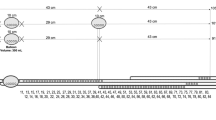Summary
Three balloons of different size were used to obtain pressures in the esopha-geal sphincters of 21 healthy young subjects. In 12 of these we had the opportunity to repeat the studies using perfused open-tip methods, and in 10 of these 12, three methods were correlated. The constantly perfused open-tip tubes were pulled through the sphincter intermittently and continuously. The balloons were pulled through the sphincter continuously.
The pressures in the inferior sphincter varied with the size of the balloon tip and with respiration but not with rate of perfusion or the lumen from which pressures were recorded. The pressures in the superior sphincter varied with all four parameters. If the four parameters were properly chosen, similar mean values and correlation of the values obtained by the various methods in an individual patient were obtained. The advantages and disadvantages of the various methods were discussed briefly.
Similar content being viewed by others
References
Botha, G. S. M., Astley, R., andCarre, I. J. A combined cineradiographic and mano-metric study of the gastroesophageal junction.Lancet 1:659, 1957.
Code, C. F., andSchlecel, J. F. The pressure profile of the gastroesophageal sphincter in man: An improved method of detection.Mayo Clin Proc 55:406, 1958.
Edwards, D. A. W., andRowlands, E. N. Physiological observations in achalasia and their significance in methods of treatment.Gastroenterologia 92:114, 1959.
MacLaurin, C. The intrinsic sphincter in the prevention of gastroesophageal reflux.Lancet 2:801, 1963.
Kelley, M. J., Jr. Esophageal motor function.Normal and pathological physiology as reflected by intraluminal manometric studies. Amer J Dig Dis 9:553, 1964.
Wilbur, D. L., III, Pollard, H. M., andSaladin, T. A. Esophageal motility tests in the diagnosis of esophageal disease.Mich Univ Med Center J 32:229, 1966.
Pert, J. H., Davidson, M., Almy, T. P., andSleisenger, M. H. Esophageal catheterization studies. I. Mechanism of swallowing in normal subjects with particular reference to the vestibule (esophagogastric sphincter).J Clin Invest 38:397, 1959.
Winans, C. S., andHarris, L. D. Quantitation of lower esophageal sphincter competence.Gastroenterology 52: 773, 1967.
Fyke, F. E., Jr., Code, C. F., andSchlegel, J. F. The gastroesophageal sphincter in healthy human beings.Gastroenterologia 86:135, 1956.
Hichtower, N. C., Jr. The physiology of symptoms.Amer J Dig Dis 5:562, 1958.
Van Trappen, G., Texter, E. C., Jr. Barborka, C. J., andVanderbroucke, J. The closing mechanism at the gastroesophageal junction.Amer J Med 18:564, 1960.
Dixon, W. J., andMassey, F. J., Jr. Introduction to Statistical Analysis. McGraw-Hill, New York, 1957.
Siegel, S. Nonparametric Statistics for the Behavioral Sciences. McGraw-Hill, New York, 1956.
Hill, J. R., Kelley, M. L., Schlegel, J. F., andCode, C. F. Pressure profile of the rectum and anus of healthy persons.Dis Colon Rectum 3:203, 1960.
Kelley, M. J., Jr. Pressure studies of the ileocolonic junctional zone of dogs.Amer J Physiol 209:333, 1965.
Pope, C. E. A dynamic test of sphincter strength: Its applications to the lower esophageal sphincter.Gastroenterology 52:779, 1967.
Author information
Authors and Affiliations
Additional information
Supported by the Mount Carmel Research and Education Corporation.
Rights and permissions
About this article
Cite this article
Rinaldo, J.A., Levey, J.F. Correlation of several methods for recording esophageal sphincteral pressures. Digest Dis Sci 13, 882–890 (1968). https://doi.org/10.1007/BF02237574
Issue Date:
DOI: https://doi.org/10.1007/BF02237574




